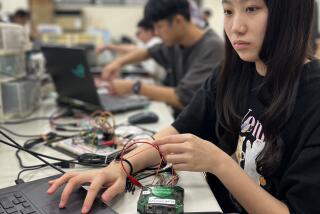Pentagon Panel Seeks Subsidy of Semiconductors
WASHINGTON â A high-level Defense Department task force, warning that the American semiconductor industry will wither unless immediate action is taken to combat foreign competition, urgently recommended Thursday that the Pentagon pump $1 billion in subsidies into an institute formed by a consortium of U.S. manufacturers.
âIt is simply no longer possible for individual U.S. semiconductor firms to compete independentlyâ against government-backed industries in Japan and elsewhere, said Norman R. Augustine, president of Martin Marietta Corp. and chairman of the special panel of business executives, scientists, engineers and academicians.
Critical to Weapons
Semiconductors, the tiny chips best known as the brains of todayâs computers, also are critical elements in a range of sophisticated weapons systems, from missiles and bombers to battle tanks and warships.
The report said that current U.S. dependence on foreign-produced semiconductors is modest but warned that âU.S. technological leadership in this critical area is rapidly erodingâ and that âwe will become highly dependent in the future if immediate actions are not taken.â
The implications âfor our country in general and our national security in particular are awesome indeed,â Charles A. Fowler, chairman of the Defense Science Board, said in forwarding the task force report to Defense Secretary Caspar W. Weinberger with a plea that he âraise this issue at the highest level of our government.â
A spokesman for Weinberger said that the task forceâs recommendations are under review and that techniques for implementation âas well as funding alternativesâ are being explored.
The task force recommended that the Pentagon provide âsupport of approximately $200 million per year for five yearsâ for the proposed Semiconductor Manufacturing Technology Institute.
That recommendation seems to dovetail with a separate, industry-sponsored effort. In that, a committee led by National Semiconductor President Charles Sporck proposed formation of a manufacturing consortium called Sematech, to be funded by industry participants and the government. Although the task force report does not identify Sematech--and, in fact, Pentagon officials carefully avoided coordinating with industry Thursdayâs release of the report--some defense officials privately have identified Sematech as the probable recipient of defense funding.
Resistance to Funding
The recommendation comes at a time of increasing congressional resistance to increases in defense spending, and apparently anticipating criticism of government subsidies for industry, task force chairman Augustine declared:
âThe fact that this investment by the government does benefit the commercial competitiveness of U.S. merchant semiconductor firms would be an unfortunate basis for withholding Defense Department support of these recommendations, which are viewed as critical for national defense.â
Some legal and government sources said that antitrust questions could be raised if U.S. companies join together in a consortium, but one Pentagon official familiar with the task force study said: âThat is not clear-cut . . . there may be forms an institute could take that would not require antitrust immunity.â
Two Efforts Under Way
Already there are two major consortium-type efforts in semiconductors, the Semiconductor Research Center in Research Triangle, N. C., and the semiconductor packaging program at Microelectronics & Computer Technology Corp., or MCC, the Austin, Tex.-based group that broke antitrust ground when it was established.
However, both those efforts are research programs only; in fact, the creation of MCC was predicated on passage of legislation that exempted some types of cooperatives from antitrust prohibitions--legislation that restricted such efforts to research and development.
Both the Defense Science Board recommendations and the Sematech proposal clearly call for manufacturing operations and even commercial sales of developed products.
The report said that the institute could produce âselected devices for DOD (Department of Defense) needsâ and that it âcould have an important impact . . . in the commercial market as well when member firms transfer technology to their own applications.â
The report suggests that a device called a 64K D-RAM would be âan appropriate technology upon which the Institute could focus its efforts.â Such a chip is a full four generations ahead of any products now being manufactured.
Focus on Memory Device
The report, in fact, focuses on D-RAM (dynamic random-access memory) devices, intricately designed circuits that store electronically coded information. Now made and sold in abundant quantities, it is considered a commodity product. It also, however, is considered a âtechnology driverâ--meaning that in learning to make such memory devices, companies gain experience and knowledge that can be applied in the development and manufacture of more sophisticated devices.
It is in such sophisticated devices, known as logic chips and microprocessors, that American companies still lead. U.S. chip makers are fighting to hold onto parts of the market for other kinds of memory devices, but claim they are hampered by the same forces that drove them out of D-RAMs.
Most U.S. chip makers abandoned D-RAMs two years ago, following drastic price drops born of Japanese-developed improvements in quality and manufacturing processes, and aggressive pricing practices that led the U.S. industry to charge the Asian companies were violating U.S. trade laws.
Within a decade of entering the semiconductor industry, the Japanese have captured nearly half of all world sales, estimated to exceed $31 billion this year, and almost all the D-RAM market.
The report identifies several areas in which it claims the U.S. lags Japanese technology but fails to assess the importance of the technologies to the overall semiconductor market. Several semiconductor experts would quarrel with some of the findings, but industry officials on Thursday generally lauded the task forceâs recommendations.
Capitalization Methods
The instituteâs initial capitalization of about $250 million could be a direct investment by participating companies or could come âby a low-interest, government-backed loan,â the report said.
In addition to the financial support for the institute, the report recommended that the Defense Department spend roughly another $1 billion. Of that, $50 million a year would be used to establish âcenters of excellence for semiconductor science and engineeringâ at eight universities. It did not specify which universities.
The report said that direct Pentagon spending for research and development in semiconductor materials, devices and manufacturing infrastructure should be increased over four years--a proposal it said would mean an extra $60 million the first year and rise to $250 million the fourth year.
And it said that $50 million a year should be set aside to âprovide a source of discretionary funds to the Defense Departmentâs semiconductor suppliers to underpin a healthy industrial research and development program.â
In urging prompt action, the report said that âthe pace of advancement of semiconductor technology is such that an entire new generation of key devices is introduced every two or three years.â
âThe current position of the overall U.S. merchant semiconductor business is concluded to be very tenuous in terms of present manufacturing capacity,â it added. âSteps to preserve its viability must be taken with dispatch.â
Gaylord Shaw reported from Washington and Donna K.H. Walters from Los Angeles.






